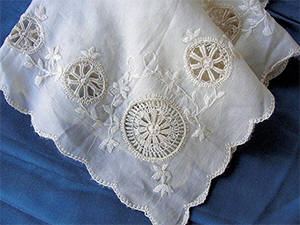| |
| |
|
|
|
| |
| |
LUXURY ON THE FRONTIER
-- SILK HANDKERCHIEFS & MORE
While depictions of
frontier garments typically portray rugged
mountainmen and pioneers in dowdy homespun attire,
the picture presented through Nicholas Dupui's
ledger paints a very different story -- fashion
considerations reigned supreme.
Whether it was by way of beaver hats, pairs of
garters, buckles, or silk handerkerchiefs worn as
neckwear, the frontier was as fashionable as
anywhere in the colony, with its own resident tailor
at hand.
The ledger records the talents of William Martin who
in 1745 paid for his purchases by "the making of a
Great Coat, a Close Body Coat, a jacket and a Small
jacket, a suit of Broad Cloath, by 3 pair of
Trousers, and by 2 pair of Leather Breeches making."
Customers, such as Abigail Sealy, could order "ye
Making a Petticoat," and examples abound of orders
for custom shoes.
Although we're unaware of the types of
handkerchiefs sold at Dupui's store, we do know
that they were available at five different price
points: cotton at 2 or 2.5 shillings, silk at
3, 4.5, and 5.5 shillings. As Dupui also sold
skeins of silk thread and silk lace, one can
well imagine that some of the handkershiefs were
embroidered in silk.
Handerchiefs worn as neckwear in the 18th
century (by both men and women), were often
printed, with striped and checked patterns more
likely to have been yarn-dyed and woven.
Consensus has emerged that these patterned
handkerchiefs were almost certainly squares,
folded into whatever shape was deemed
fashionably appropriate. |
|
 |
As to how often luxury items
were sold, the ledger indicates that silk items were
sold on nine occasions, and ten beaver hats were sold to
patrons by 1744. Customers who purchased silk
handkerchiefs could also be seen simultaneously buying
"a pair of Womans Stockins," a "Dozen Knives & forks," a
"yard of Nonesopritty," or "a Beaver Hatt."
|
|
| |
|
|
|
|
|
| |
|
|
|
| |
|
|
|
| |
|
|
| |
|
|
|
|